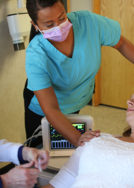
Scaling and root planing, gum grafts, ginigival contouring, laser treatment, and maintenance
Periodontal (gum) disease is an infection attacking the bone and supporting structures around teeth. Healthy teeth have bone that surrounds them like a cuff. A periodontal infection causes bone to melt away. After time, the teeth may lose their support and become loose.
When predicting the possibility of gum disease, we look at a patient’s overall health. Statically, people with diabetes or heart disease may have an increased possibility of heart attacks or strokes if they also have periodontal disease. Also, patients are at an increased risk if they have poor oral hygiene, smoke, take steroids or blood pressure drugs, or have a family history of gum disease.
Periodontal disease is caused by bacteria. The white sticky film that forms on teeth is called plaque, which contains bacteria that inflame the gums. The inflammation process creates periodontal “pockets,” where bone has been lost and bacteria harbors. Plaque eventually hardens into tartar, further trapping bacteria. The gums become red and swollen as the bacteria attacks the tissues around the tooth.
At a patient’s first visit to our office, the dentist or hygienist will check gums with a periodontal probe. Generally, the more severe the disease, the deeper the pockets. We may also take X-rays to diagnose any bone loss.
If periodontitis is caught early, we can generally arrest the disease process with a professional cleaning and possibly “scaling and root planing.” As the disease progresses, scaling and root planing is the mainstay of treatment. It removes the diseased tissue and bacteria from the pocket, as well as cleans and smooths the surface of the root to eliminate areas where plaque can reside.
If the pockets do not heal after scaling and root planing, periodontal surgery may be needed. The dentist performs a surgical procedure whereby she may contour the underlying bone and stitch the gums more closely to the teeth.
After surgery, our dental team will concentrate on maintenance. The hygienist may recommend visiting the office every three to four months to have scaling completed. She may also recommend placing an antibiotic in the periodontal pockets to eliminate any active infection. Then, she re-measures the gums with a periodontal probe to see if the disease is progressing or subsiding. The hygienist works with patients to achieve good oral hygiene and learn how to clean difficult areas that have heavy tartar.
The realm of periodontics also includes gum grafting in areas where the tissue is thin and wearing away (recession). In this case, we take skin from the roof of the mouth to cover an area of recession.
Sometimes aggressive periodontal disease requires a dentist solely specializing in periodontal disease. Dr. Vessel and her team recognize when the disease progresses, there are times when it is best to refer a patient to a periodontist. After any surgical procedure is completed by a specialist, the patient typically can return to our office for follow-up care.



